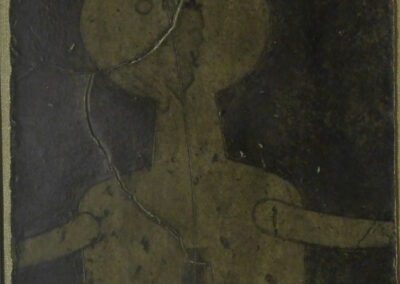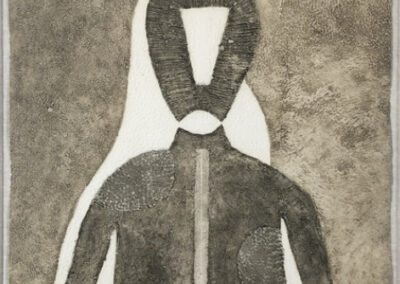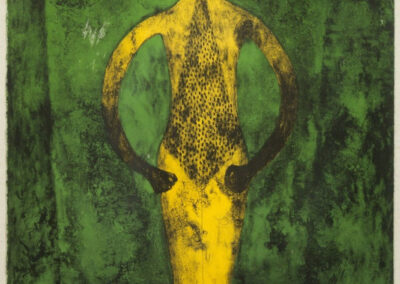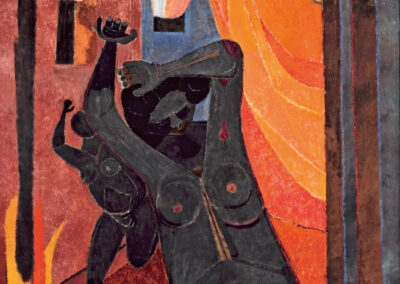Our next Artist You Need To Know is Rufino Tamayo. His full name was Rufino del Carmen Arellanes Tamayo (1899 – 1991) and he was a Mexican painter of Zapotec heritage, born in Oaxaca de Juárez, Mexico: very active in the mid-20th century in Mexico and New York (his disconnect from some of his contemporaries in Mexico and his time spent in New York is a fascinating story of artistic independence and growth), his paintings blended figurative abstraction with surrealist influences.
“Painting”, Tamayo said, “is not literature, or journalism or demagogy. Painting is…the wonderful combination of poetry, which bears the message, and visual qualities, that transmit the meaning.”
-

Figura en negro, 1980
-

Figura en Verde (Figure in Green), 1977
-

Hombre en Gris, 1976
-

Hombre en Negro (Man in Black), 1976
-

El Personnage, 1975
-

Chacal (from The Mexican Masters Suite), 1973
Tamayo was a Mexican painter and printmaker: his work is recognizable immediately for his vivid use of colour and expressionistic, painterly style. His contemporaries included significant artists like Diego Rivera, David Alfaro Siqueiros and José Clemente Orozco: like them, Tamayo injected a Mexican sensibility into conversations about modernism and painting. He was influenced by European movements like Cubism, Surrealism and Expressionism, but – again, like the previously mentioned artists – Tamayo redefined them in a way that had more relevance to his own experience, his own place and history, and expanded what those movements could, and must be, to be important to himself and the contemporary society he lived within.
Tamayo attended the Escuela Nacional de Artes Plásticas San Carlos in Mexico City for only one year, preferring to chart his own educational and artistic path. Later, he joined the department of ethnographic drawing at the city’s Museo Nacional de Arqueología, where he immersed himself in the collection of pre-Columbian art. He moved to New York in the 1930s, after some tension with several of his fellow muralists and would not return to Mexico permanently until 1959. “I had difficulty with the muralists, to the point that they accused me of being a traitor to my country for not following their ways of thinking. But my only commitment is to painting. That doesn’t mean I don’t have personal political positions. But those positions aren’t reflected in my work. My work is painting.”
“In New York”, Tamayo said, “I went berserk over painting. There, I experienced the same passion that I had felt during my encounter with early and pre – Hispanic Art.”
-

Smiling woman, 1989
-

Sandias con Manzana (Watermelons with Apple), 1985
-

Protesta, 1983
-

Three People, 1970
-

Death on a Pale Horse, from Apocalypse of Saint John, 1959
-

Venus Noire, 1969
Tamayo’s artwork blended aspects of European modernism, Mexican folk art, and pre-Columbian ceramics. His paintings and prints with vivid, intense colour and often blocky, minimalist compositions (informed both by Indigenous motifs from Mexico and the more ‘contemporary’ influences of Pablo Picasso and Georges Braque) were blends of historical and modern aesthetics.
Rufino Tamayo has been honoured with many prizes and various official awards for his career and accomplishments. These include the National Prize for Arts and Sciences in Fine Arts of Mexico (1964), the Gold Medal of Merit in the Fine Arts of Spain (1985) and the Belisario Domínguez Medal of Honor by the Mexican Senate (1988); he was also a Grand Officer of the Order of Merit of the Italian Republic (1989) and an Honorary member of the National College of Mexico, 1991.
His artwork has been exhibited in many museums and galleries worldwide: the Solomon R. Guggenheim Museum in New York City; The Phillips Collection in Washington; the Cleveland Museum of Art in Cleveland, Ohio; the Naples Museum of Art in Naples, Florida; Oklahoma City Museum of Art in Oklahoma City, Oklahoma; and The Museo Nacional Centro de Arte Reina Sofia in Madrid, Spain. One of the most important of these was Tamayo: The New York Years, which was on display at the Smithsonian American Art Museum from 2017 to 2018.
His works are in the collections of the Tate, the Museum of Modern Art, the San Francisco Museum of Modern Art, the Guggenheim, and the Smithsonian American Art Museum.
-

Perro Aullando (Howling Dog), 1960
-

Claustrophobia, 1950s
-

Lion and Horse (León y caballo), 1942
-

The Philosophy of the Boudoir, n.d
-

Fire (Fuego), 1946
-

Factory Workers' Movement (Movimiento fabril), 1935
In 1959, Tamayo and his wife, Olga Flores, returned to Mexico permanently and Tamayo built an art museum in his home town of Oaxaca, the Museo Rufino Tamayo. In 1972, Tamayo was the subject of the documentary film, Rufino Tamayo: The Sources of his Art by Gary Conklin.
Tamayo painted his last painting in 1990, at the age of 90: Luna y Sol (Moon and Sun).
-

La Mujer con Máscara Roja (The Woman with the Red Mask), 1940
-

Retrato de Olga (Portrait of Olga), 1964
-

Luna y Sol (Moon and Sun), 1990
Many more of his works can be seen here, and the site for the Tamayo Contemporary Art Museum is here. A fine timeline of his artistic career and historical legacy can be seen here.




















